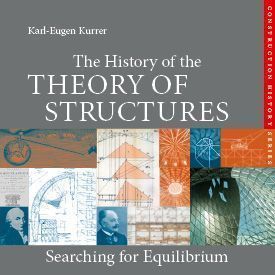Proceedings of the Institution of Civil Engineers – Engineering History and Heritage
Vol. 164, February 2011, Issue 1, S. 55
„German publisher Ernst & Sohn has brought to the English-speaking public this substantial monograph by Karl-Eugen Kurrer, which is a revised and considerably extended version of the highly successful 2002 German edition Geschichte der Baustatik. The additional content, especially the inclusion of more international developments, makes this book of truly worldwide significance.“
Prof. Dr. Andreas Kahlow, Fachhochschule Postdam
Costruzioni Metalliche
62 (2010), No. 4, S. 90.
„Das Buch ist sehr gut lesbar, da jedes Kapitel kurz aber vollständig ist, stets von hohem wissenschaftlich-technischen Interesse ist und ohne Wiederholungen oder Überlappungen mit anderen Teilen des Bandes auskommt. Besonders lobenswert sind die Querverweise – immer präsent, präzise und punktuell – zwischen den theoretischen und den praxisorientierten Teilen. Die graphische Gestaltung des Buches ist sehr sorgfältig und gelungen; es ist mit zahlreichen historischen Tafeln und Illustrationen ausgestattet, die von Kurrers Engagement beim Schreiben sowie von der Professionalität der Experten der Vergangenheit zeugen. Zusammenfassend kann gesagt werden, dass das Buch aufgrund der originellen Konzeption und seines inhaltlichen Reichtums von großem Interesse für diejenigen ist, die sich beruflich mit Baukonstruktion befassen. Darüber hinaus, wird die stets angenehme und interessante Lektüre dadurch erleichtert, dass jedes Kapitel in sich schlüssig und selbstständig ist.“ (übersetzt von Dr. Simona Becchi und Dr. Antonio Becchi)
Ass. Prof. Dr. Claudio Bernuzzi (Politecnico di Milano)
News of Bridge Construction - Brückenbaukurier
No. 1, 2010, S. 76-77.
“Das Buch von Karl-Eugen Kurrer (…) ist das erste Buch, das ein geschlossenes Bild der Jahrhunderte dauernden Geschichte der Baumechanik bietet und an die Fachleute in der ganzen Welt gerichtet ist. (…) Die Monographie von K.-E. Kurrer ist unter den Publikationen zur Geschichte der Baumechanik und ihrer Anwendung in mehreren Jahrhunderten äußerst bedeutsam. (…). Sollte das Buch in die russische Sprache übersetzt werden, wird es einen fruchtbaren Einfluss auf die Forschung auf dem Gebiet der Baumechanik und Baukonstruktionen in unserem Land haben.“ (übersetzt von Dipl.-Ing. Torsten Hoffmeister)
Prof. Dr. W. W. Kosmin (MFTI – Moskauer Staatsinstitut für Physik und Technologie), Ingenieur A. M. Giuljasisow
Masonry International
Vol. 21, 2008, No. 2, p. viii
[...] "This is the first book to present a holistic history of structural theory aimed at international professional circles. [...] The book is the first to offer an overview of the development from conventional structural theory to structural mechanics and computational mechanics during the last century.”
CONSTRUCTION HISTORY – Journal of the Construction History Society
Vol. 23 (2008), pp. 138-139
"The structure of the book makes it a joy to read, for its avoids the sequential approach taken in many histories in favour of a thematic approach which allows the reader to follow the key themes in depth without being sidetracked by developments in unrelated fields. The author also provides a well-balanced narrative of mathematical details, practical engineering, and the people themselves involved with various aspects of the history of structural theory."
Dr. Bill Addis, Buro Happold, London, UK)
Technische Mechanik
Band 30, 2010, Heft 4, S. 414
„[…]Kurrer offers us a highly interesting work on a fascinating subject, carefully and detailed explained, which may help all engineers and scientist to find the historical roots of science. In particular, this book will be highly welcome to all teachers in the field of mechanics.”
Professor Dr.-Ing. Albrecht Bertram, Lehrstuhl für Festigkeitslehre der Otto-von-Guericke-Universität Magdeburg
HoST - Journal of History of Science and Technology (online)
Vol. 3, Fall 2009
[...] "There is no doubt about the pertinence of Kurrer’s book for the field of history of science and technology.” [...]
Marta Macedo, PhD Candidate, Department of Architecture, University of Coimbra (Portugal).
Problems of Strength
5/2008, S. 134-138
[...] This "history of theory of structures" could only have been written by an expert, an engineer who knows the discipline inside out. Engineering scientists geeting to grips with their own history is a rare thing.
em. Prof. Dr.-Ing. Dr.-Ing. E. h. Dr. h. c. Ekkehard Ramm, Universität Stuttgart
Journal of Structural Engineering
March 2009, S. 330-331
[...] Ultimately, this is an extraordinary book that should be in every engineering library and on the bookshelf of every structural engineer who aspires to make a difference in the design, development, and preservation of civil infrastructure.
Prof. Sashi K. Kunnath (Dept. of Civil and Environmental Engineering, University of California, Davis)
Stahlbau
11/2008, S. 837
Fazit: Das Buch bietet auf verschiedenen Ebenen sehr interessante Einblicke in die Entstehung der Baustatik und in die Baustatik selbst. In den einzelnen Unterkapiteln ist reichlich Raum für gezielte Fragestellungen und Details. Die Details sind nicht chronologisch, sondern stets in einem größeren Zusammenhang thematisch einander zugeordnet. Auch die Einflüsse von Bauingenieuren in anderen Technikbereichen wie Kranbau, Schiffbau und Flugzeugbau und deren Rückwirkung auf die Statik der Baukonstruktion selbst werden miteinbezogen. Dadurch ergibt sich insgesamt ein geschlossenes Bild von der Entwicklung der Baustatik. Empfehlung: Überaus lesenswert.
Dr.-Ing. Holger Eggemann, Brühl
Journal of Architecture and Building Science
Vol. 123 (1582), 2008, No. 11, p. 77
[...] The history of structural engineering was started by Todhunter and Pearson, and continued by Timoshenko in his “History of Strength of Materials” dating from 1953 (already available in Japanese). After that, half a century passed before this author, based in Europe, presented us with very many original documents that may well attract readers to explore the science of the history of structural engineering by reading this book.
em. Prof. Dr.Eng. Minoru Yamada, Kobe University
Materialprüfung – Materials Testing
11-12/2008, Volume 50, S. 687
[...] It provides a complete overview of the development of the static and strength theories, starting with the development of geometric thinking during the renaissance which laid the foundations for classical mechanics. [...]
Prof. Dr.-Ing. Thomas Böllinghaus (Vizepräsident der Bundesanstalt für Materialprüfung und –forschung (BAM), Berlin)
Casabella
numero 770, n. 10/2008, anno LXXII, p. 101 (ottobre 2008)
„…Ed è un libro di storia a pieno titolo…” „…Und es handelt sich wahrhaftig um ein historiographisches Buch…” [AdR]
Prof. Francesco Dal Co, Chefredakteur CASABELLA
Stahlbau-Nachrichten
2/2008, S. 60
Karl-Eugen Kurrer hatte beriets seiner 2002 erstmalig erschienenen Ausgabe "Die Geschichte der Baustatik" seinen sehr eigenen Stempel aufgedrückt, und jetzt erscheint dieses gelungene Werk, aktualisiert und erheblich erweitert, in englischer Sprache. [...]
Dr.-Ing. Volkmar Bergmann, Hauptgeschäftsführer des Deutschen Stahlbauverbandes (DSTV)
Architectural Science Review
Volume 51, Number 4, December 2008, S. 415-416
It would form a valuable resource in any library concerned with the history of structures or development of structural theories and methods, and a reference work for any teacher and student in this areas.
Peter R Smith, MArch PhD Sydney, FAIA, University of Sydney, Australia
Beton- und Stahlbetonbau
1/2009, S. 74
Das Buch in seiner englischen Originalfassung ist ein wunderbares Werk, welches die Bedeutung der Geschichte im strukturellen Ingenieurbau unterstreicht. Es bildet ein Werk, das zum kurzen Nachlesen von statischen Verfahren und auch gleichzeitig zur Aneignung von Hintergrundwissen bezüglich der zugehörigen geschichtlichen Entwicklungen geeignet ist.
Dipl.-Ing. Dr.habil. Alfred Strauss, Ph.D, Universität für Bodenkultur, Wien
Schweissen und Schneiden
6/2008, S. 360
[...] Erstmalig wird eine zusammenfassende Darstellung der Entwicklung von der klassischen Baustatik zur Strukturmechanik und "Computational Mechanics" im letzten Jahrhundert geboten. [...]
Dipl.-Ing. Dietmar Rippegather, Chefredakteur „Schweissen und Schneiden“
Welding and Cutting
5/2008, S. 314
[...] It is the first to offer an overview of the development from the conventional structural theory to structural and computional mechanics during the last century. Brief summaries of the development of common calculation methods, supported by historic sketches, provides insides to the history of structural mechanics and present-day calculation methods.
Dipl.-Ing. Dietmar Rippegather, Editor-in-Chief „Welding and Cutting“
Stahlbau-Nachrichten
2/2008, S. 60
Karl-Eugen Kurrer hatte beriets seiner 2002 erstmalig erschienenen Ausgabe "Die Geschichte der Baustatik" seinen sehr eigenen Stempel aufgedrückt, und jetzt erscheint dieses gelungene Werk, aktualisiert und erheblich erweitert, in englischer Sprache. [...]
Dr.-Ing. Volkmar Bergmann, Hauptgeschäftsführer des Deutschen Stahlbauverbandes (DSTV)
Architectural Science Review
Volume 51, Number 4, December 2008, S. 415-416
It would form a valuable resource in any library concerned with the history of structures or development of structural theories and methods, and a reference work for any teacher and student in this areas.
Peter R Smith, MArch PhD Sydney, FAIA, University of Sydney, Australia
Isis (History of Science Society)
Vol. 100, Issue 3, pp. 639-640 (September 2009)
[...] For the time span covered (1575 to the present), this is the most complete recent book on the topic of methods of structural engineering design.[...]
Professor Dr. Thomas Boothby (Professor of Architectural Engineering, The Pennsylvania State University)
ARCH+, Zeitschrift für Architektur und Städtebau
42. Jahrgang, September 2009, Heft 193, Seite 7.
[...]Dieses Buch ist durchaus nicht nur für Insider des Bauingenieurwesens geschrieben. Kurrer gelingt in seinen Ausführungen der schwierige Spagat zwischen wissenschaftlicher Genauigkeit und allgemein verständlicher Anschaulichkeit, wozu auch die umfangreiche Bebilderung beiträgt. (…) Jedem, der sich auch für die theoretische Seite des Bauens oder die Geschichte der Technikwissenschaften interessiert, sei dieses Buch mit Nachdruck empfohlen.
Dr.-Ing. Arch. Rolf Gerhardt (ist Architekt und Akademischer Oberrat am Lehrstuhl für Tragkonstruktionen der Fakultät für Architektur der RWTH Aachen)
Strain
Vol. 45, Issue 4, pp. 387-388 (August 2009)
[...] This unique book, written by an expert on the subject, presents an authoritative account of the history of the theory of structures. The author presents the historical developments with a critical spirit and philosophical perspective. The book is well written and organized. It is highly recommended to the engineer, the teacher, the scientist and the researcher who is interested in the historical developments of the evolution of the theory of structures.
Professor Dr. Emmanuel E. Gdoutos (Democritus University of Thrace, Xanthi, Greece)
ZAMP (Zeitschrift für Angewandte Mathematik und Physik)
Vol. 60 (2009), S. 581
[...] Whenever you want to learn about the subject or just want to browse through history – this is the book! It is certainly a must for every historically interested engineer as well as for historians of science. ‘The Kurrer’ will become the standard reference book and will stay in that position for many years to come.
Prof. Dr. Thomas Sonar (Institut Computational Mathematics, Technische Universität Braunschweig)
Technology and Culture
July 2009, Vol. 50, pp. 669-674
E S S A Y R E V I E W S
The Art of Building in Its Many Forms
[...] As you can tell from my enthusiasm, I recommend this highly original study, first as a pleasure to read and a thoughtful examination of new avenues to explain the development of human understanding, and also as an aid and inspiration for further research.
Prof. Dr. Tom F. Peters is professor emeritus of architecture at Lehigh University
Meccanica
45 (2010), pp. 131-134
„An encyclopaedic work of this extension and completeness has never been published before, and one is amazed that it has been the fruit of the culture and the patience of a single scholar.”
Prof. Dr. Piero Villaggio (Dipartimento Ingegneria Strutturale, Università di Pisa, Italy)
Mauerwerk
13. Jahrgang Juni 2009, S. 163f
„The History of the Theory of Structures …“ ist nicht irgendein Buch zur Geschichte der Baustatik, es ist das Fachbuch zu diesem Thema, mit der vorliegenden englischen Ausgabe auch im internationalen Umfeld. Dem praktisch tätigen Ingenieur vermittelt es die historischen Zusammenhänge eines Kerngebietes seines Berufsstandes. Dem lehrenden Ingenieur gibt es ein mögliches methodisch-didaktisches Konzept einer neuen, historisch-orientierten Lehre zur Hand und liefert den Stoff für eine entsprechende Statiklehre gleich mit. Dem forschenden Ingenieur ermöglicht es den schnellen Zugriff zu Fakten, Hintergründen oder vertiefender Literatur. Dem Studierenden erklärt es den historischen Kontext zu einem der spannendsten Studienfächer des Bauingenieurwesens, und alle Genannten lädt es zur Auseinandersetzung mit der Geschichte des eigenen Berufes und damit auch mit sich selbst ein. Eine Auseinandersetzung, die mehr Bedürfnis sein sollte als Pflicht.
Dipl.-Ing. Volker Wetzk (BTU Cottbus)
Engineering Structures
30 (2008) p. 2957
[...] It is clear that Dr. Kurrer has succeeded in combining the rigorous and the romantic in a work that should become classic reading for the discerning mechanician, engineer and architect.[...]
Prof. Dr. Milija N. Pavlovic (Imperial College London, UK)
ATZ Automobiltechnische Zeitschrift
9/September 2008, S. 851
Die Entwicklung technischer Güter kommt heute nicht mehr ohne die Simulation aus. Das geschichtliche Fachbuch "The History of the Theory of Structures" ist zu diesem Thema in englischer Sprache neu erschienen.
Beratende Ingenieure
5/6 2008, S. 67
Beginnend mit den Festigkeitsbetrachtungen Da Vincis und Galileis spürt der Autor den einzelnen baustatischen Verfahren und ihrer Formierung zur Disziplin "Baustatik" nach: [...]
ZAMM Journal of Applied Mathematics and Mechanics
Vol. 88, No. 10, October 2008, p. 792 [...] Kurrers book is fascinating and it has already become part of my teaching. I would like to recommend it not only to students and civil engineers; it is of great interest to all interested in load-bearing structures, wherever in aerospace engineering, mechanical engineering, sport-equipment industry, etc. It is an opus of uniqueness.
Prof. Dr.-Ing. habil. Norbert Gebbeken (Bundeswehr University, Munich, Germany)
International Journal of Space Structures
Vol. 23, No. 3, July 2008, p. 194
[...] Kurrer's achievement in compiling this book is colossal, and I commend it to anyone interested in the subject. It will, for a long time, stand well along side the other classics of the field - Timoshenko's "History of Strength of Materials", and Eduardo Benvenuto's "Introduction to the History of Structural Mechanics". [...]
Dr. Bill Addis (Buro Happold, London, UK)
Marine Structures
Vol. 22 (2009) p. 855-856
[...] The book certainly contains a wealth of interesting information, and I believe that every department of structural engineering ought to have a copy on its shelves.
Prof. Dr. Kolbein Bell (Department of Structural Engineering, Norwegian University of Science and Technology, Trondheim, Norway)
Journal of Architectural Engineering
Volume 14 / Issue 4 December 2008, p. 130
[...] Kurrer's book is truly a masterpiece. In the 800-plus pages, one finds no end of new and interesting pieces of information that contribute to the history of the theory of structures. [...]
Prof. Dr. Harry H. West (The Pennsylvania State University, USA)
Bautechnik
85. Jahrgang, September 2008, Heft 9, S. 656-657
[...] Das vorliegende Werk ist weit mehr als ein Fachbuch zur Geschichte einer technikwissenschaftlichen Disziplin. Es ist spannendste Ingenieurlektüre in einer heute selten gewordenen, gepflegten Sprache [...]
Prof. Dr.-Ing. Dr.-Ing. E.h. Willfried B. Krätzig (Krätzig & Partner, Bochum, Germany)
Australian Journal of Structural Engineering
Vol 8, No 3, p. 259
[...] Undoubtedly for many readers Kurrer's book will represent an excellent opportunity to gain different perspectives and to broaden horizons. For others it will simply be a pleasure to browse and read, and to be reminded of structural engineering's incredible intellectual underpinnings. Highly recommended. [...]
Prof. Dr. Robert Melchers (University of Newcastle, Australia)
Progress in Aerospace Sciences
45 (2009) p. 80-81
[...] The book contains a wealth of information and will be an important reference text for engineers and historians who wish to understand or write about any specific aspect of the history of structures. Especially, those who teach this subject should find this book to be a rich source of information. It does much more than to discuss the science, however, because we meet the major figures who played significant roles and we learn much about them personally. [...]
Dr. Hubert I. Flomenhoft (Palm Beach Gardens, Florida, USA)
Canadian Journal of Civil Engineering
35 (2008), p. 1486-1487
[...] this is an encyclopedia of a somewhat esoteric subject to some, but of interest and importance to those concerned with the origins of the design of structures: bridges, cranes, buildings, soil mechanics, ships or airplanes. Teachers of structural mechanics will find the book invaluable, as there is, in addition to the usual equations found today in textbooks, much more detailed information about the evolution of ideas and theories over time. [...]
Dr. Ralph Francis (Civil Engineering Department, University of New Brunswick, Frederiction, Canada)
Archives of Civil Engineering
Volume LIV, Issue 3, p. 650
[...] this book is an outstanding achievement of its author since it illustrates the history of the theory of structures, throughout ages, from its very beginnings until the present day. It can be a very good help in teaching of structural mechanics and of some related subjects. Surely, it puts a substantial impact on the proper development of civil engineering students and their teachers. Also, it is valuable for the practising engineers, who can enlarge their professional and intellectual qualities. Certainly, they will find the importance of knowledge passing from one generation to another [...]
Prof. Dr. hab. Inz. Zbigniew Cywinski, Gdansk University of Technology, Poland
Steel Construction - Design and Research
Volume 1, September 2008, Issue 1, p. 93 [...] This book offers fascinating insights into the emergence of theory of structures and structural analysis itself on various levels. [...]
Dr.-Ing. Holger Eggemann (Hegger+Partner Ingenieure, Aachen)
Cement & Concrete Composites
30 (2008), p. 1023
[...] The book is well illustrated with pictures, graphs, historical drawings and sketches, which makes for entertaining reading. It contains a wealth of information and is therefore ideal as a textbook for historians, especially those interested in the history of technology, but also professional engineers and graduate students of engineering and art history. It is a must for libraries and engineering departments. [...]
em. Prof. Dr.-Ing. Dr. h.c. Dr. E.h. Hans-Wolf Reinhardt (University of Stuttgart, Germany)
Recommendations
- Winter, Stefan / Peter, Mandy (eds.)
Holzbau-TaschenbuchGrundlagen
10. Edition – August 2021- XIV, 546 pages
- Hardcover
- German
ISBN: 978-3-433-01805-7available- €99,00
- de Borst, René / Crisfield, Mike A. / Remmers, Joris J. C. / Verhoosel, Clemens V.
Nichtlineare Finite-Elemente-Analyse von Festkörpern und Strukturen
October 2014- 587 pages
- Softcover
- German
ISBN: 978-3-527-33660-9out of print - more




